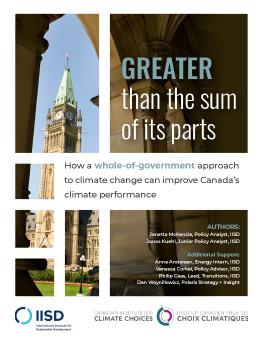
Greater Than the Sum of its Parts
How a whole-of-government approach to climate change can improve Canada's climate performance
Canada's federal government should adopt a whole-of-government approach to climate change. Such an approach can leverage executive leadership to encourage cross-departmental collaboration and integrate climate change into all government policy-making. Canada can learn how to establish an effective whole-of-government approach from the successes and challenges of its peers both at home and abroad. This report examines whole-of-government approaches to climate change from around the world as well as specific lessons learned from three case studies: the United Kingdom, the United States, and British Columbia.
Climate change is a complex, cross-jurisdictional issue that requires societal transformation. To meet this challenge, governments must be able to make climate policies that work across sectors, communities, and regional borders. A whole-of-government approach can help to mainstream climate change into policy-making processes.
Effective climate policies that get Canada where it needs to go will require the active involvement of departments as disparate as Finance, Infrastructure, Transport, Natural Resources, Environment and Climate Change, Agriculture and Agri-Food, Crown-Indigenous Relations and Northern Affairs, Public Safety and Emergency Preparedness, Employment and Social Development, and others. This broad reach necessitates a coordinated approach to ensure the coherent implementation of a climate strategy.
Whole-of-government approaches to climate change have become a feature of some national and subnational governments over the last several years, as countries commit to increasingly ambitious measures to curb their greenhouse gas emissions, adapt to climate change, and pursue clean growth strategies. An integrated, coordinated, cross-departmental approach can leverage departmental expertise, reduce policy redundancies, mainstream climate change into all decision making, and create cross-departmental synergies for more effective climate governance.
In this paper, eight countries were surveyed to identify whole-of-government structures and processes dedicated to climate change, and three of these cases (the United Kingdom, British Columbia, and the United States) were analyzed in-depth to determine the benefits and risks of such an approach. Five lessons can be learned for implementing a cohesive and effective whole-of-government approach to climate change:
- The success of a whole-of-government climate initiative depends on sustained executive leadership directing departmental priorities and interdepartmental coordination.
- An effective whole-of-government climate initiative requires adequate funding, a clear mandate, and the capacity to enact change across departments.
- An effective whole-of-government climate initiative requires effective and empowered personnel acting in whole-of-government structures.
- The mandates of participating departments must align or be brought into alignment with the mandate of the whole-of-government climate initiative.
- A whole-of-government climate initiative should report publicly on its progress and be as transparent as possible about its deliberations, findings, and research.
Participating experts
You might also be interested in
What’s Next After UNEA-6: Why “synergies” is more than a buzzword
In an era marked by escalating environmental challenges and geopolitical tension, the Sixth United Nations Environment Assembly (UNEA-6) called for more cooperation to tackle the triple planetary crisis.
UNFCCC Submissions Tracker
Tracking and sharing opportunities for stakeholders to give input to the UN climate change negotiations.
The State of Global Environmental Governance 2023
In global environmental talks in 2023, the focus across nearly all issue areas was funding implementation and reviewing performance.
The Critical Next Step: What you need to know about Canada’s 2030 climate target
Canada's climate target for 2030 is within reach, but more stringent policies and clearer government communication will be needed to get there. Our expert explains why these developments are critical for Canada to help avoid the worst impacts of climate change.